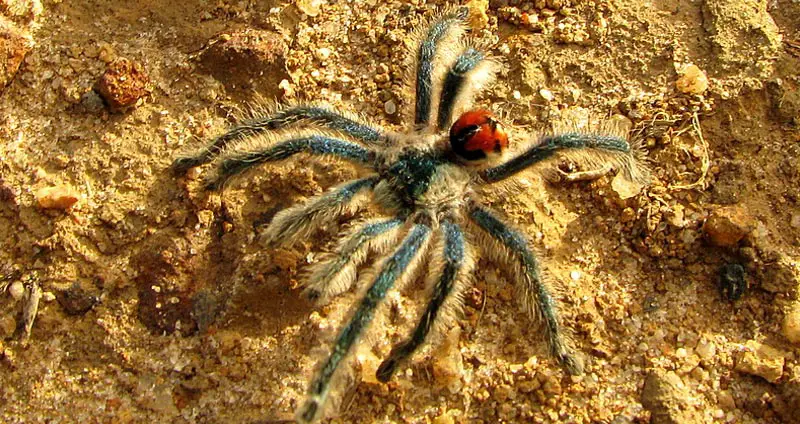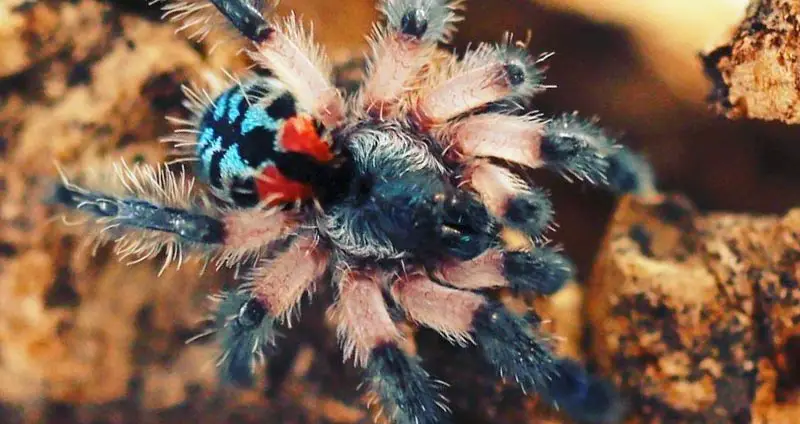If you’ve never heard of this tarantula before, you’re in for an absolute treat. While there are over 800 different types of tarantulas, some stand out as the most beautiful and interesting species.
Typhochlaena seladonia, or the Brazilian Jewel tarantula, is one of those that stand out from the rest.
This post will detail everything that you need to know about this stunning tarantula. Where it’s from, how it behaves, and how to properly care for it.
Table of Contents
Typhochlaena seladonia Care Sheet
Common Name |
Brazilian Jewel |
Species Type |
New world arboreal |
Habitat |
Found in Bahia and Sergipe, Brazil, specifically the Atlantic Rainforest. They hide out in the bark of trees, creating “trapdoors”. |
Growth Rate |
Medium-to-fast growth rate. Their adult size is very small, so they reach this size quite fast. |
Adult Size |
Females reach a legspan of about 2.5″, with males often only measuring slightly under 2″. |
Lifespan |
There aren’t many credible sources that state the lifespan of this species. However, in general females live between 10 and 15 years while males live about 4. |
Enclosure |
The enclosure should be taller than it is wide, with plenty of materials to climb on. It’s important to match the enclosure to the natural habitat of this tarantula. Two inches of substrate should line the floor, and water should always be available. The enclosure should have good airflow. |
Temp/Humidity |
78°F to 82°F with about 75% to 85% humidity. |
Diet |
Due to its size, it doesn’t eat a lot. It’s given flightless fruit flies as it grows, and then eats pinhead or small crickets about twice per week. |
Temperament |
Quite a docile tarantula. Relatively inactive as it sits within its trapdoor waiting for prey. Rarely flicks hairs and virtually never bites. |
Experience Level |
Intermediate – Very easy to care for temperament-wise. However, it can be difficult to supply it with an optimal enclosure. |
Average Cost |
Slings ~ $600, Males ~ $700, Females ~ $800+ |
Typhochlaena seladonia Appearance
While this tarantula has many incredible characteristics, its colorful appearance is undeniably the reason behind why it’s so well-received and desired by enthusiasts. Its body features reds, blues, yellows, blacks, pinks, and everything in-between. This coloration, combined with a bulbous abdomen, make it, frankly, adorable.
One thing to note about this tarantula is that it’s absolutely tiny — a dwarf species. Females have legspans of up to 2.5″, while males typically don’t grow beyond 2″. Males also feature longer legs but smaller abdomens. This size allows T. seladonia to exhibit some interesting characteristics, but it also makes it a bit hard to observe both in nature and in captivity.
Typhochlaena seladonia slings are incredibly small, but still exhibit much of the coloration that adult specimens have. Their growth rate is fairly average, but they’re able to reach their full size in a short time because of the small size of adults.

Typhochlaena seladonia Temperament
This is a tarantula that doesn’t just go about its day like any other tarantula. Instead, it has a unique characteristic that differentiates itself and makes it a joy to own. Typhochlaena seladonia is a trapdoor tarantula, creating camouflaged trapdoors in the bark of trees in order to keep themselves hidden and ambush prey.
In the wild, these tarantulas are observed ripping bark off of a tree in a vaguely circular pattern, taking refuge in its place, and then covering itself with the bark. It will then lie and wait until it feels vibrations from prey walking by, at which point it ambushes the prey and pulls it back under the trapdoor.
This behavior still persists in captivity, with Typhochlaena seladonia constructing trapdoors in a variety of different materials. This results in it being a decently dormant species, which combined with its small size can make it not great for display.
This species is also a new world species, which generally means that the tarantula is more calm, friendly, and prefers to run away from danger instead of fighting it. The Brazilian Jewel tarantula is no exception as it rarely flicks hairs at its owners and virtually never bites. So, it’s a friendly species, but it still isn’t recommended that you handle it!
Housing Typhochlaena seladonia
Proper housing of the Brazilian Jewel is what makes it a bit of a difficult tarantula to own. As stated, it has a natural trapdoor-creating behavior, so this must be permitted within their enclosure.
Fortunately, putting just a little bit of effort into the creation of the enclosure should result in an environment that’s more than healthy.
Optimal Enclosure
As this is a dwarf tarantula species, it requires an enclosure that’s a lot smaller than a typical tarantula enclosure. T. seladonia is an arboreal species, so it needs to be kept in a terrarium that has more of an emphasis on height than floor space. It should also have a healthy amount of cross-ventilation, in addition to great security.
For this small species, an enclosure like the Exo Terra 8″ x 8″ x 12″ terrarium is perfect for it. It has enough floor space for it to roam around on the ground, in addition to plenty of vertical height to create a tree-like environment. Other smaller, cheaper plastic enclosures can be used — just make sure that there’s a healthy amount of airflow.
Enclosure Decorations
As stated, the inside of the enclosure needs to allow for the creation of Typhochlaena seladonia‘s trademark trapdoors. This is largely done with the inclusion of a large cork bark hide that fills up a good portion of the enclosure.
Choose a hide that has lots of natural holes and divots that the tarantula can hide in. As most hides won’t be able to be stripped apart like tree trunks, you should also provide some sphagnum moss and shaved cork bark at the base of the vertical hide.
Typhochlaena seladonia will be able to take these scraps and use their webbing to fashion it into a functional trapdoor.
In addition to this hide, you should like the bottom of the enclosure with about 2 inches of moisture-retaining substrate, a fake plant, and a necessary water dish.

Enclosure Temperature/Humidity
This species is found in an area of Brazil that has a tropical climate with very few fluctuations throughout the year. Temperatures tend to sit between 65°F and 85°F, with moderate rainfall that picks up in spring and summer months.
Therefore, the optimal temperature for Typhochlaena seladonia is between 78°F and 82°F, which isn’t too far off from room temperature for most people. If the room that the tarantula is kept in is too cold, a gentle heat lamp (that doesn’t give off light) or a space heater can be used. Often times this isn’t necessary.
Humidity levels need to be decently high, but the enclosure shouldn’t be “swampy”. This can be achieved through keeping the water dish constantly filled and the substrate dampened with a spray bottle every third day or so.
Temperature and humidity conditions can be consistently measured with a thermometer/hygrometer tool.
Diet
For such a small tarantula, this species is decently voracious! It sits and waits within its trapdoor, ambushing prey as it walks by. Typhochlaena seladonia doesn’t possess great hunting skills, so it depends on the element of surprise.
Slings are given flightless fruit flies until they reach their juvenile/adult stage, at which point they’re given pinhead or small crickets. This is a small species, so it should never be given food that could potentially harm it during the ambush process.
As for feeding frequency, a small cricket given 2-3 times per week tends to be optimal. Each tarantula is slightly different, though, so you may need to feed yours slightly more or less.
Health Concerns
Captive-held tarantula don’t experience many health issues as long as they’re properly fed and their enclosures are optimal. The most common problems that pet tarantulas experience are dehydration and mites, but these are easy to avoid and deal with.
It’s important to note that if you don’t provide your Typhochlaena seladonia with the ability to create trapdoors, it won’t be able to properly hunt. This may result in malnutrition and death in extreme cases. So, it’s very important that their enclosure is created to the best of your ability.
Additionally, this species needs higher levels of humidity, so it’s important to make sure that their enclosure is ventilated properly. Swampy conditions can be detrimental to their health.
Typhochlaena seladonia For Sale & Price
If you’re looking to add this tarantula species to your enclosure, your wallet will definitely be feeling it. It’s an extremely rare species that’s only recently been bred, so supply is very limited. This results in it being one of the most expensive tarantulas available to date.
Most of the specimens that you’ll see are sold as spiderlings, and these tiny quarter-inch creatures can fetch around $600. Adult males are a bit more, and females near $1000 per specimen. This makes Typhochlaena seladonia inaccessible for most people.
However, if you’re a die-hard tarantula enthusiast, it may be worth forking over the money. This is a species that’s absolutely beautiful, has a very unique way of hunting, and is exclusive enough to make it a grail for most collectors.

